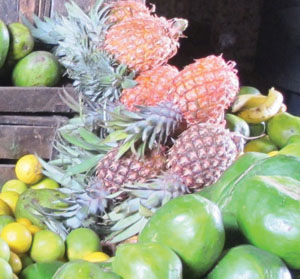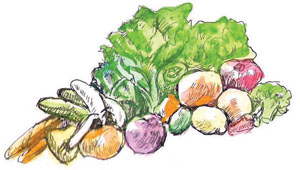7.2 The use and function of food
7.2.1 What is food?
Food consists of edible materials such as meat, bread and vegetables; it may be raw (like fresh fruit, Figure 7.2) or cooked, processed or semi-processed. Food is a nutritious substance eaten by us to maintain our vital life processes. It is a fundamental need, a basic right and a prerequisite to good health.

Food can be described in a number of different ways. Here are some terms you will find useful:
- Perishable food: food items that have a short storage life and will become spoiled or contaminated if not preserved and handled properly, e.g. meat, eggs, milk, fruits, vegetables and the like.
- Non-perishable food: foods which are not easily spoiled or contaminated, e.g. sugar and cereals.
- Wholesome food: food which is sound, clean and free from harmful ingredients – it is suitable for human consumption.
- Food hazard: food that is contaminated with biological, chemical or physical agents and, if eaten, will cause ill health.
The Nutrition Module covers all the food groups in detail and how they are used by the body.
Food is essential for the existence of all living things. Our bodies need food for energy production, to survive and to remain strong. For good health you need a balanced diet; this means that you don’t just eat one foodstuff, but you eat a range of foods so that you can get everything your body needs. The health of children will be improved and they will grow taller if they are given a healthy, balanced diet rich in protein, energy and vitamins.
Foodstuffs are of two main kinds: organic (carbohydrate, proteins, fats) and inorganic (water, various mineral elements and vitamins). The organic components are sources of energy for growth, cell multiplication, tissue repair, work and maintaining the vital processes of life. The inorganic components are believed to facilitate the physiological functions of the body, such as the regulation of blood circulation and the nervous system.
As well as being nutritious and balanced (Figure 7.3), to fulfil our needs food should also be palatable (which means tasty and good to eat) and culturally and psychologically acceptable. We should want to eat the food and have no cultural and social difficulties in eating it. Importantly, food should not contain harmful substances which are a risk to the health and wellbeing of the consumer.

Food for energy, growth and development
Food is needed to provide energy for movement, work and maintaining vital functions of the body, e.g. the heart needs energy to circulate blood in our body. Food is needed to repair and replace our body cells.
Social function of food
Food has always served an important function in the social interactions between people. In Ethiopia many social occasions are centred around food. During the many holidays, families prepare particular foods and drinks to celebrate the occasion. Food is also served at social events such as weddings and funerals. On all of these occasions, food indirectly serves as an instrument to develop social bonds and relationships.
Psychological function of food
In addition to nourishing the body and filling a need in our social life, food satisfies certain emotional needs. People who travel to or live in a new land often find adjusting to the unfamiliar food and food customs a serious problem; they feel anguish and a longing for their customary food. Food can also be used to express feelings for example, the giving of food is a sign of friendship. Serving favourite foods is an expression of special attention and recognition, and the withholding of wanted foods can be a means of punishment.
Whatever the occasion or purpose for serving and eating food, special attention must be paid to its handling at all stages to attain a good sanitary quality, otherwise it could turn out to be a source of illness and dissatisfaction.
7.1 Important principles in food hygiene and safety
